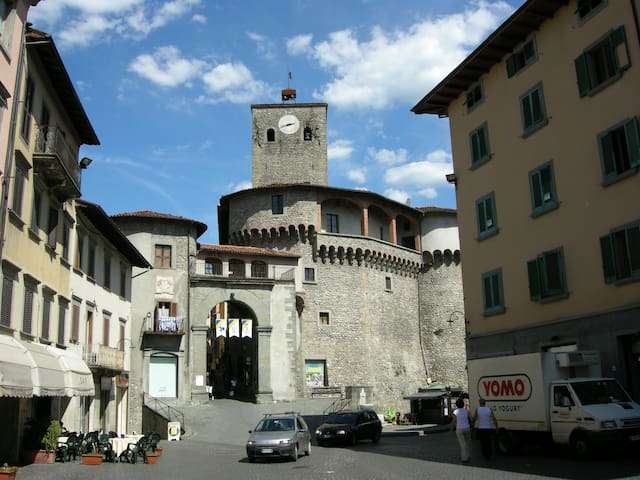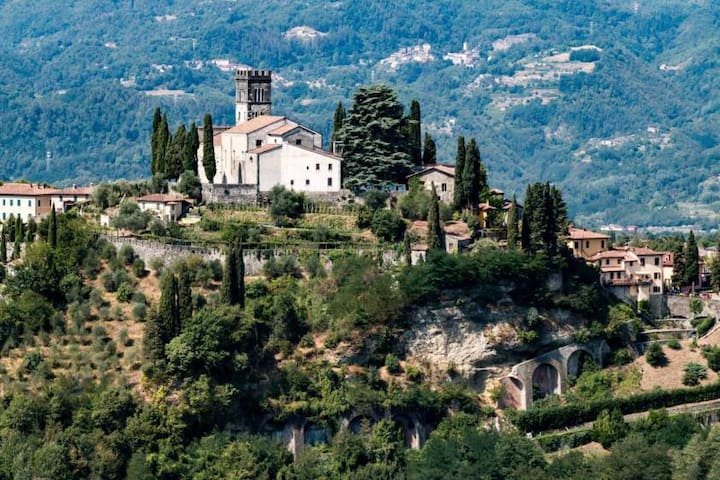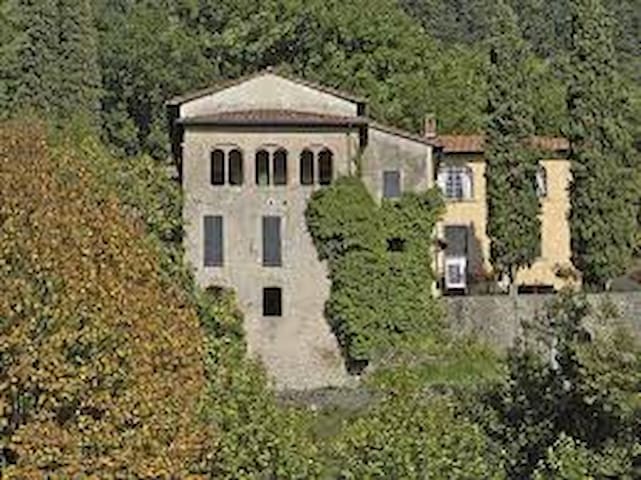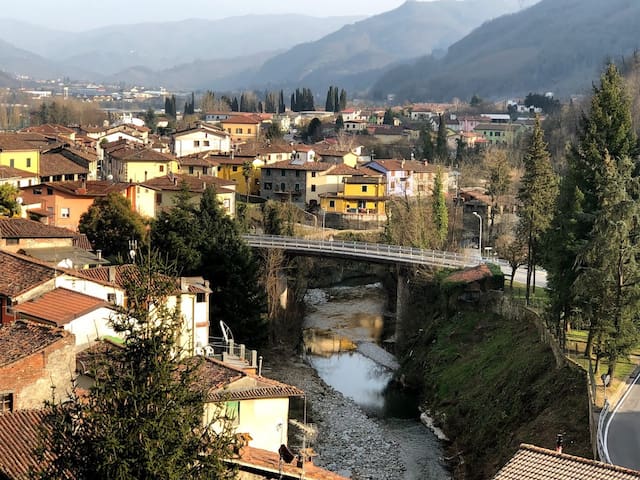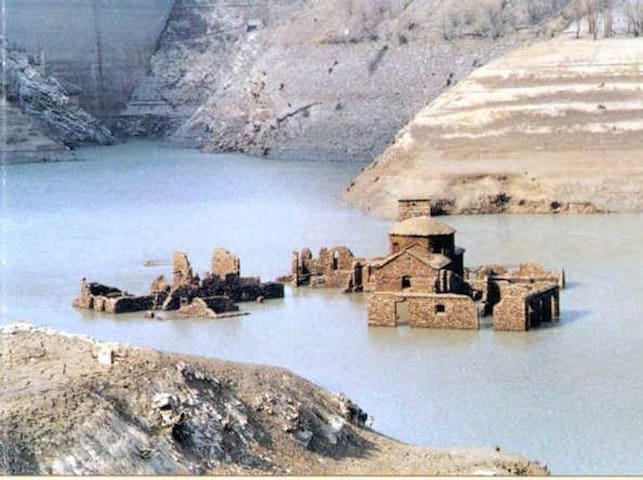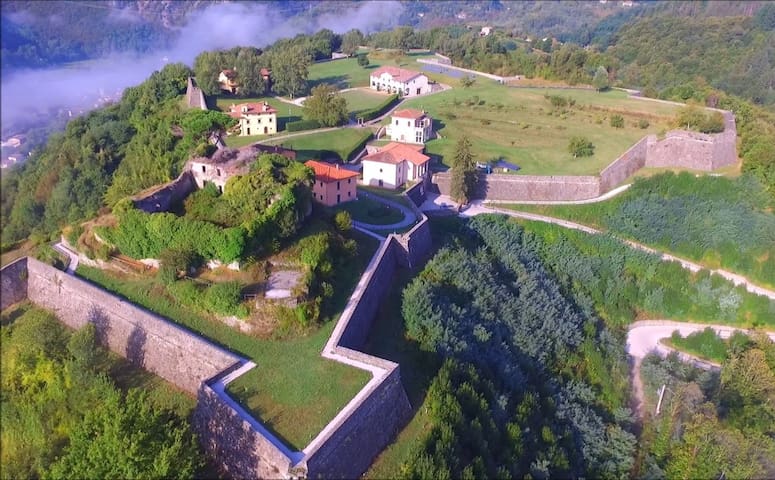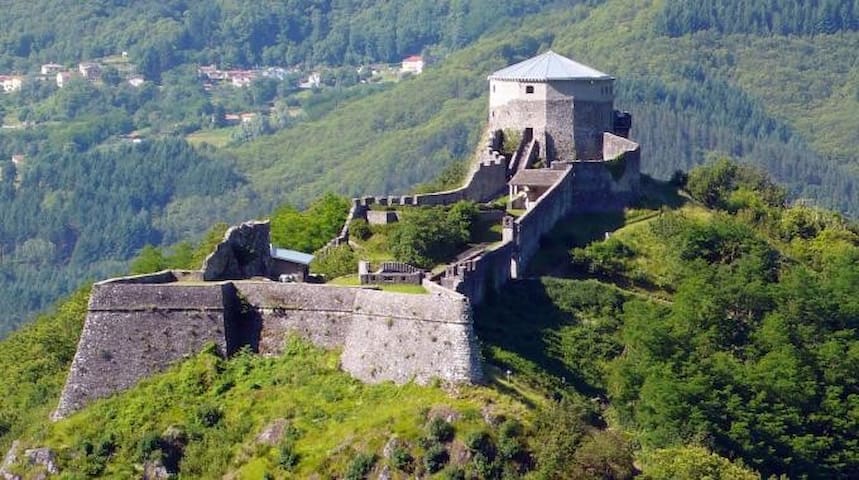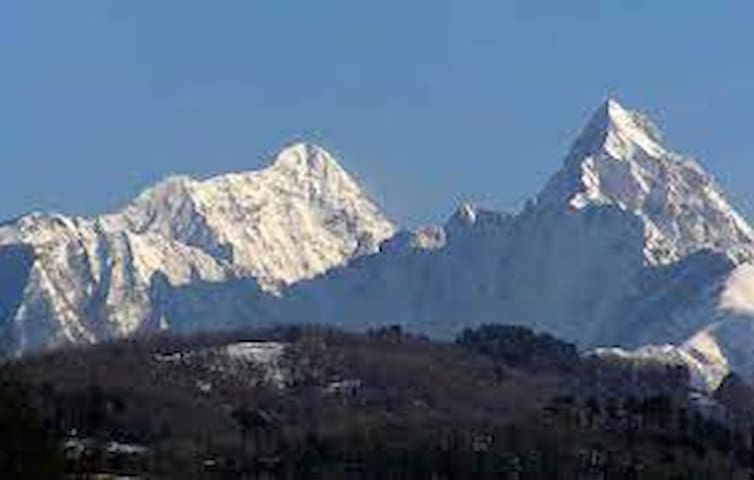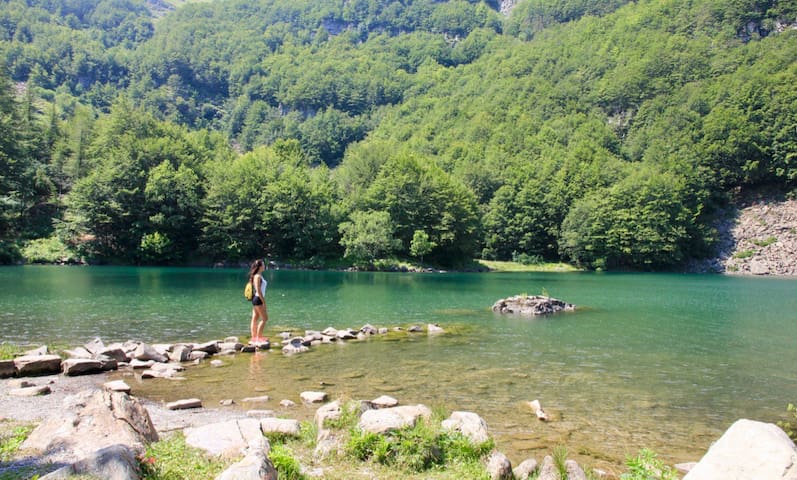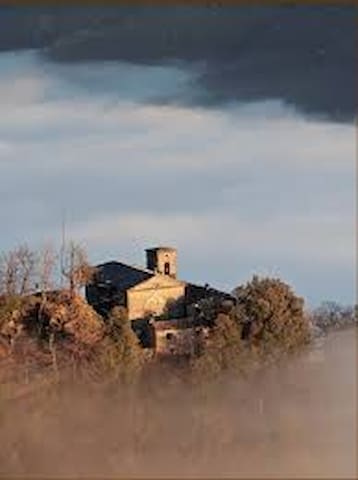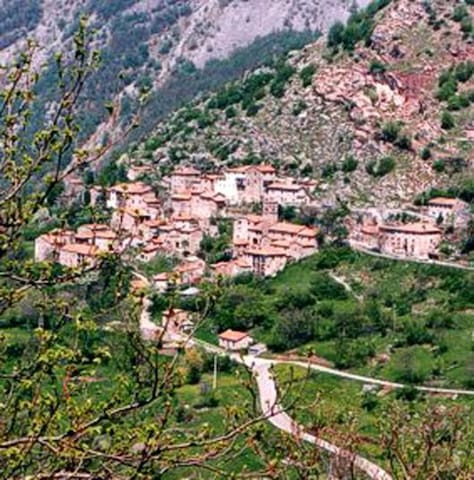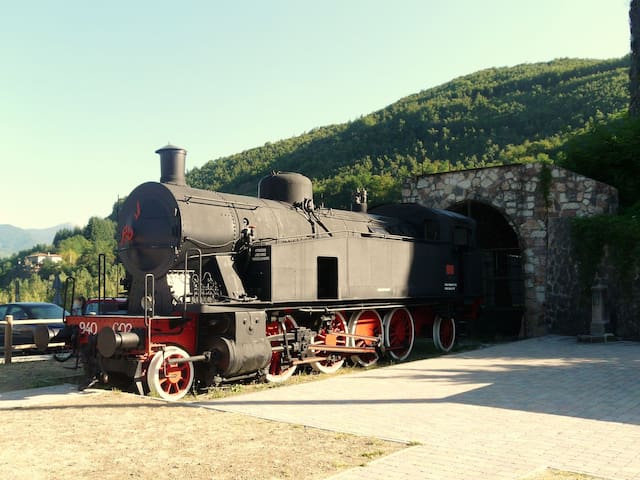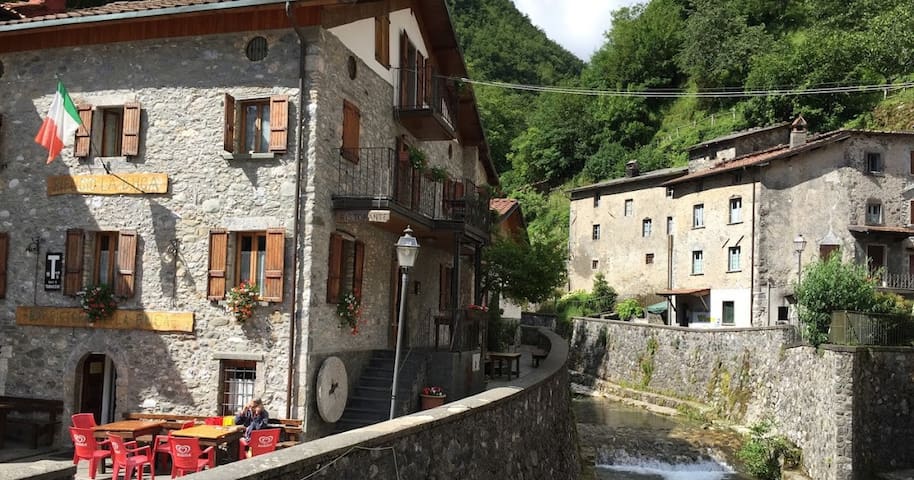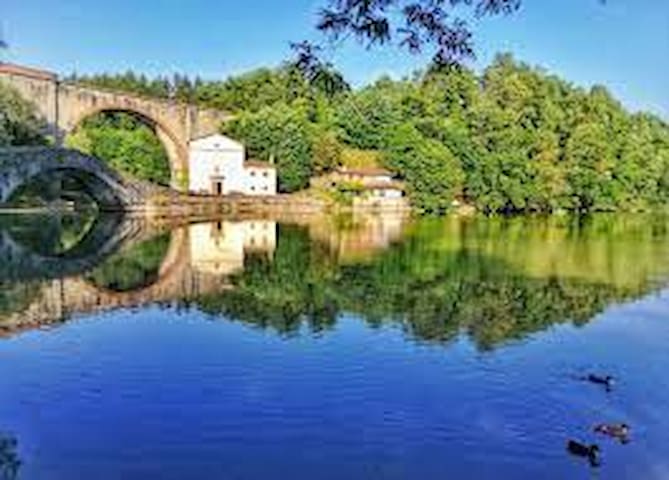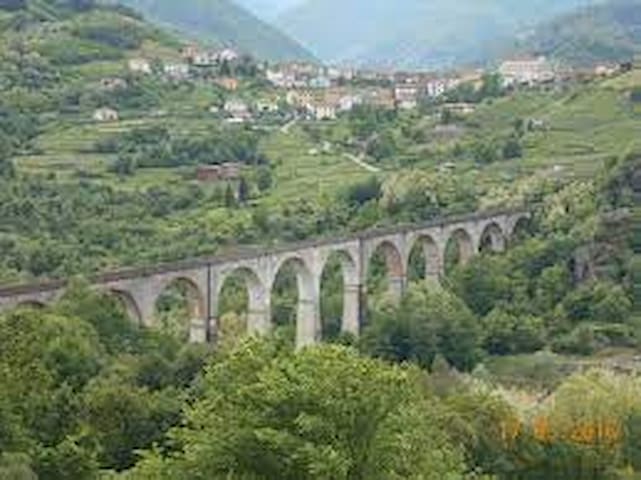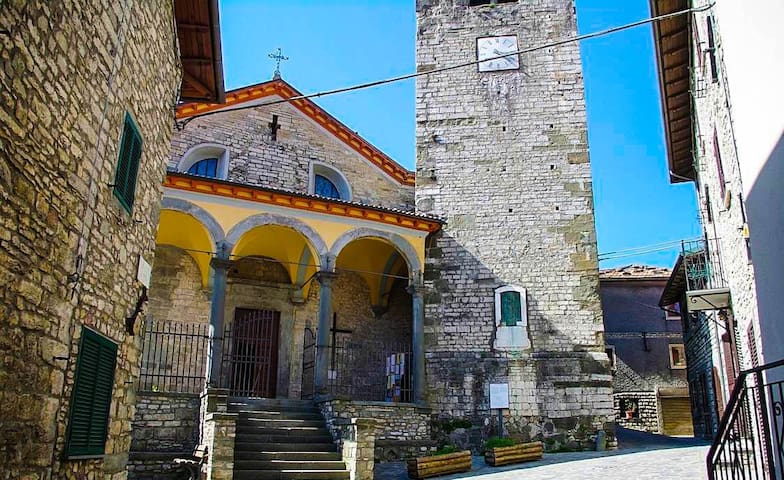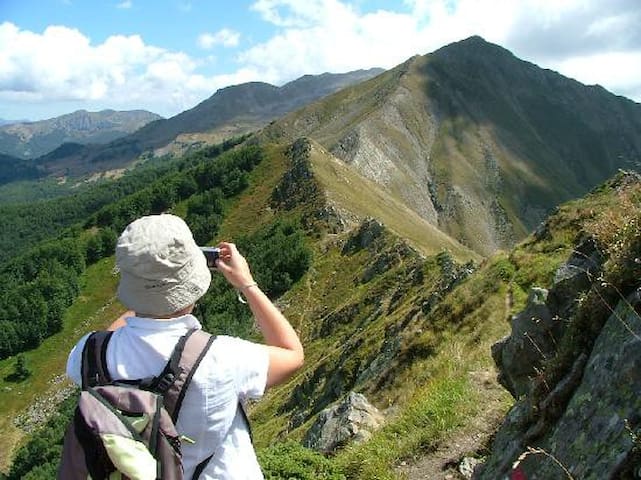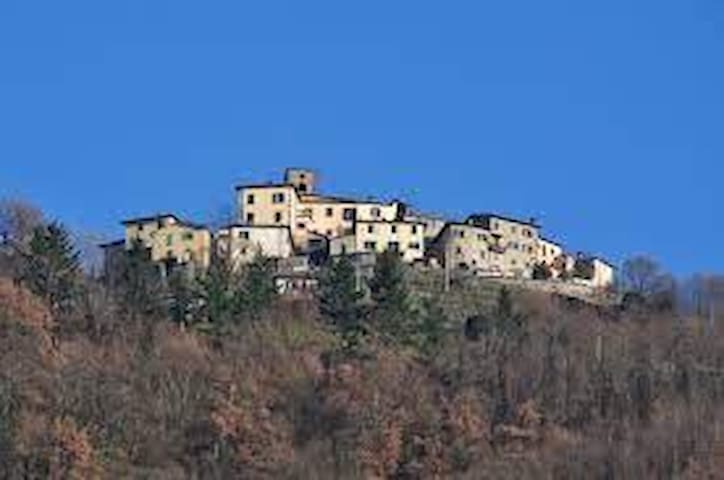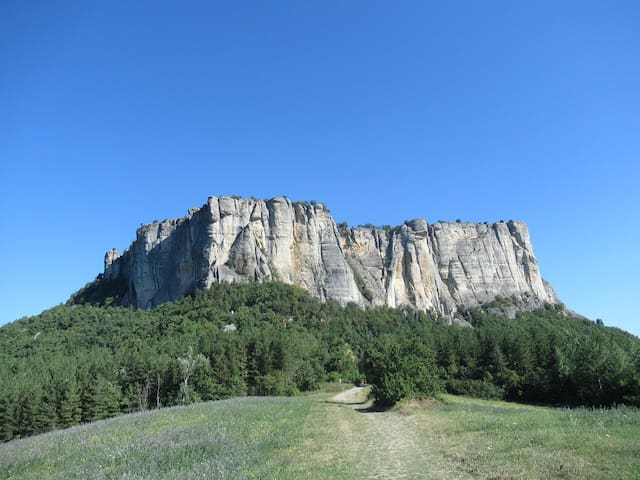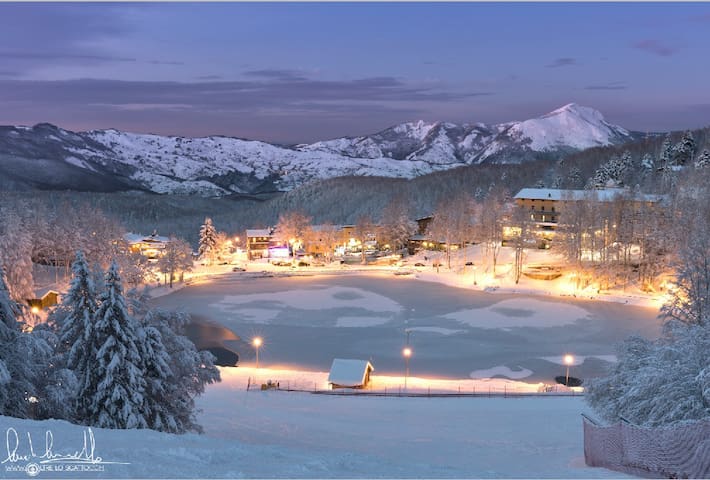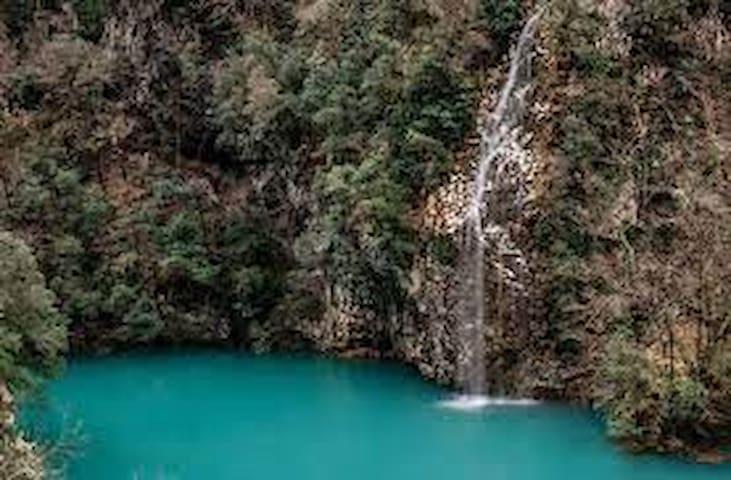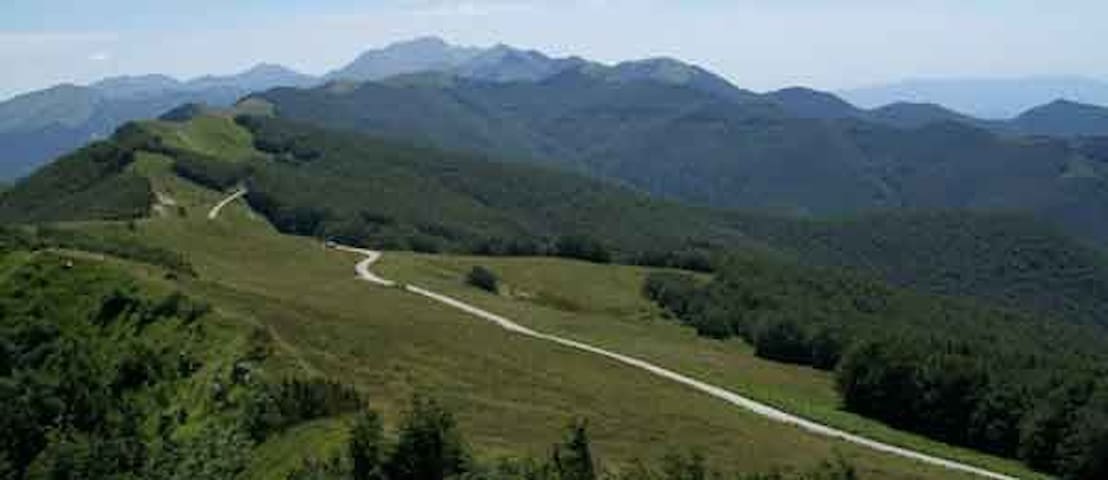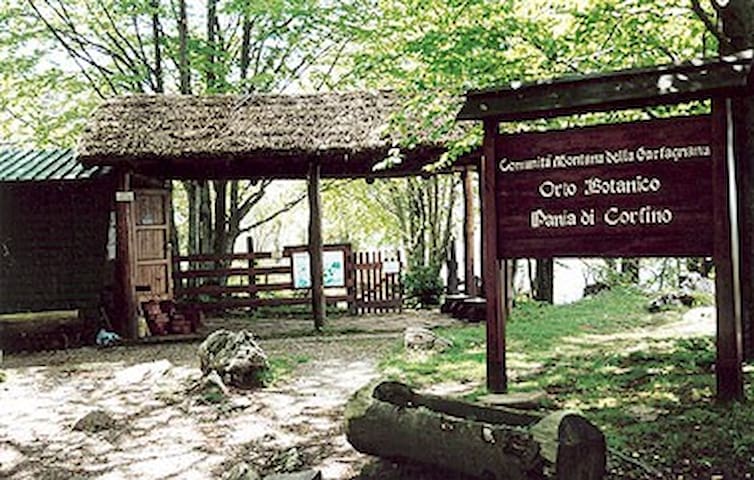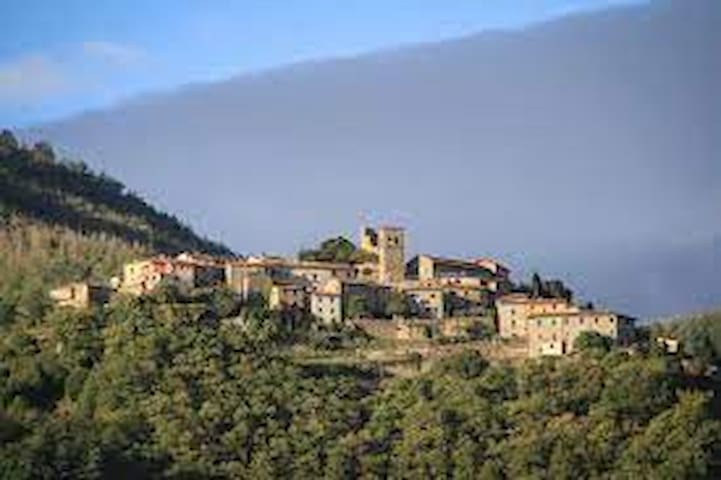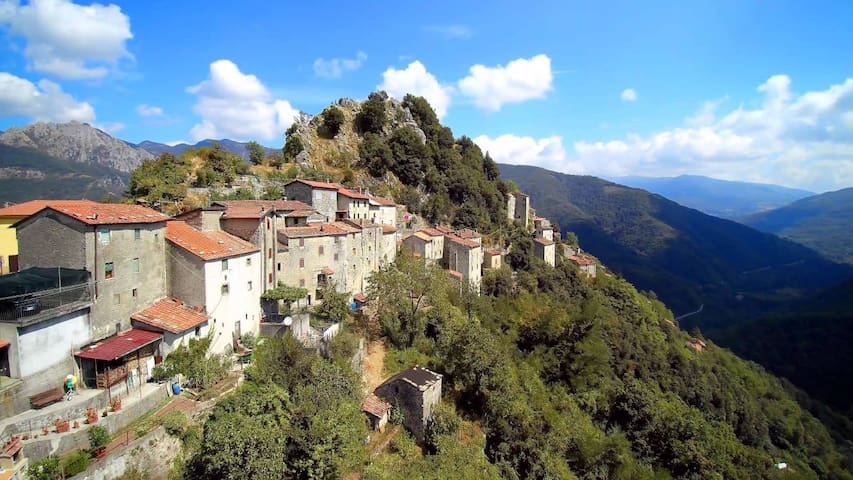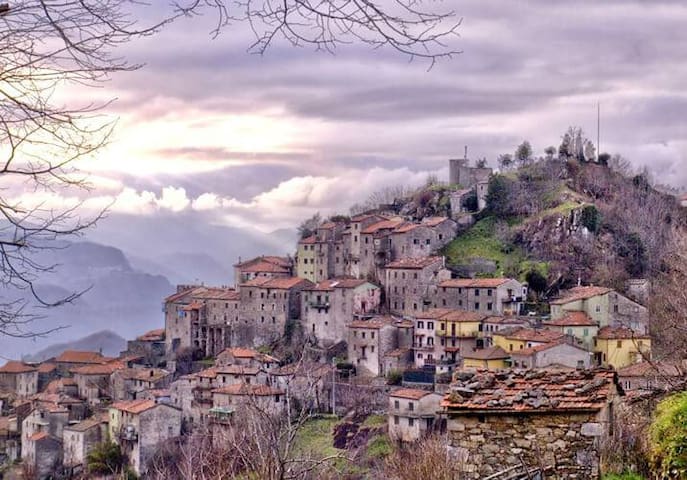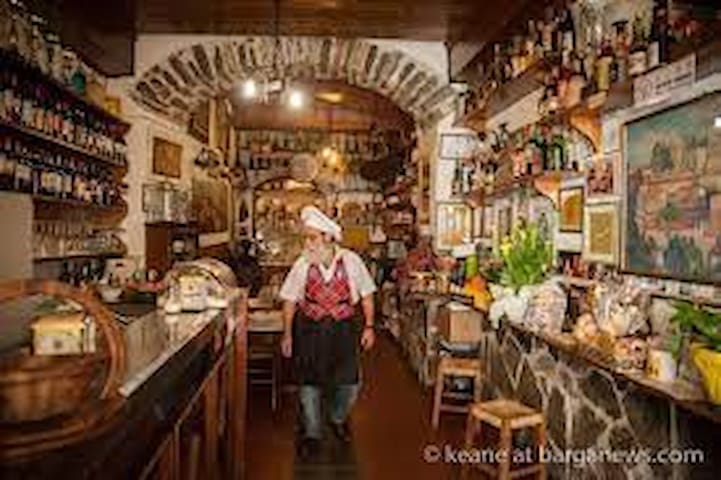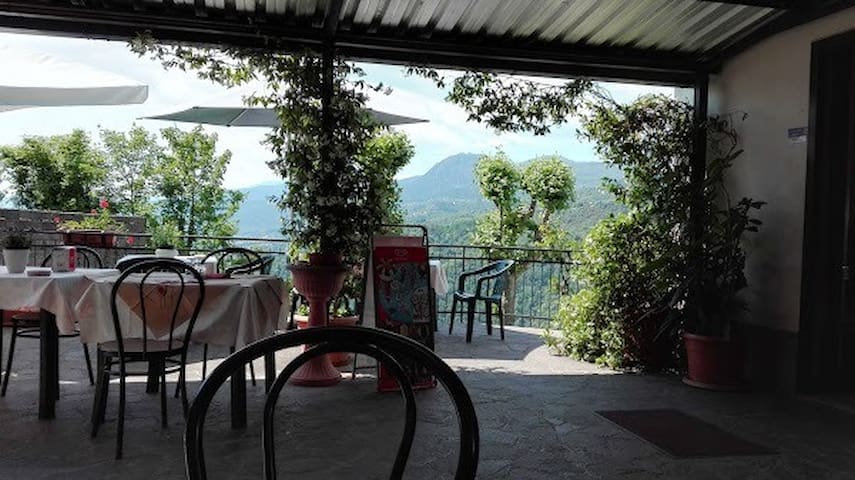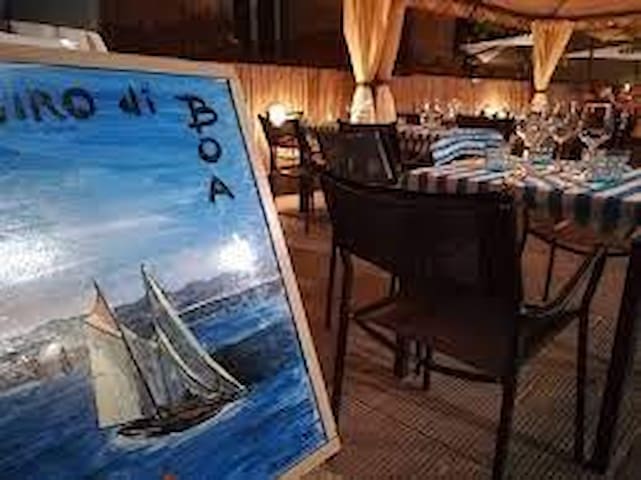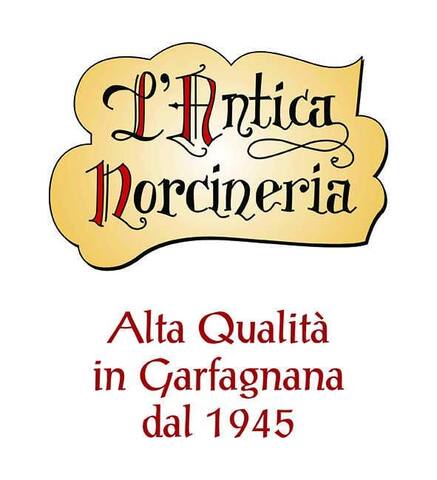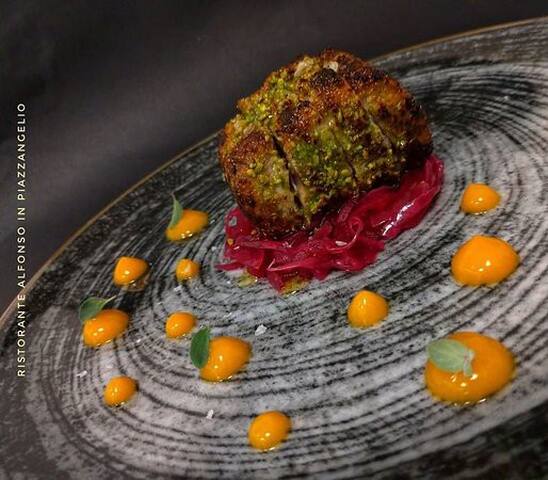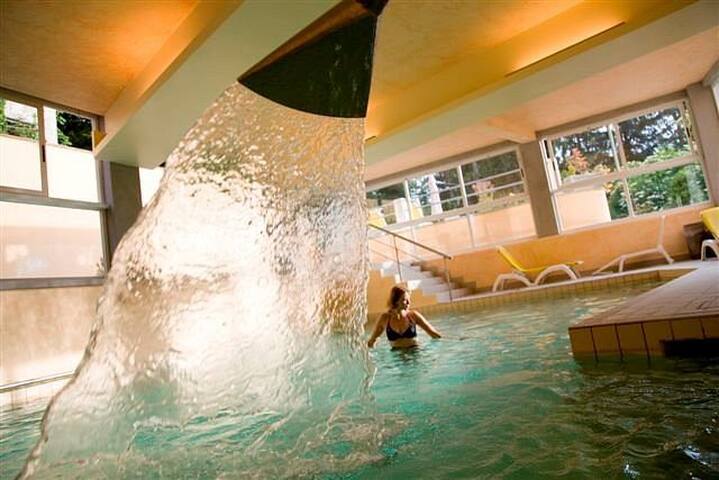Cities and place to visit
A smart guide to visit a cities and fairytale places
Historic center of Garfagnana land.
To visit historic center with its bars and typical restaurants, the ancient castle called "Rocca Ariostesca"
Thursday morning weekly open market in the alleys and squares of the center
97 locals recommend
Castelnuovo di Garfagnana
Historic center of Garfagnana land.
To visit historic center with its bars and typical restaurants, the ancient castle called "Rocca Ariostesca"
Thursday morning weekly open market in the alleys and squares of the center
Barga, the main center of the Serchio valley.
Rich in history, art, culture.
Definitely to visit the whole historic center with its characteristic alleys called "carraie"
A visit to the cathedral, the Teatro dei Differenti and the numerous churches scattered throughout the town is not to be missed
Numerous places to eat excellent typical food.
95 locals recommend
Barga
Barga, the main center of the Serchio valley.
Rich in history, art, culture.
Definitely to visit the whole historic center with its characteristic alleys called "carraie"
A visit to the cathedral, the Teatro dei Differenti and the numerous churches scattered throughout the town is not to be missed
Numerous places to eat excellent typical food.
Small and characteristic village in the middle Serchio valley.
To visit: Casa Pascoli, the Tuscan home of the great Poet and the small church of S. Niccolò from which you can enjoy a beautiful view of the Apuan Alps.
7 locals recommend
Castelvecchio Pascoli
Small and characteristic village in the middle Serchio valley.
To visit: Casa Pascoli, the Tuscan home of the great Poet and the small church of S. Niccolò from which you can enjoy a beautiful view of the Apuan Alps.
The wind cave (in the local dialect "hole of the wind") is located in the mountain range of the Apuan Alps, under Mount Pania in Vergemoli in the municipality of Fabbriche di Vergemoli.
158 locals recommend
Grotta del Vento
The wind cave (in the local dialect "hole of the wind") is located in the mountain range of the Apuan Alps, under Mount Pania in Vergemoli in the municipality of Fabbriche di Vergemoli.
Historic stone bridge.
It is considered the gateway to the Serchio Valley
Rich in history and folklore.
The Ponte della Maddalena (called Ponte del Diavolo) crosses the Serchio river near Borgo a Mozzano.
Due to the shape of its tallest, broadest and most peculiar, almost inhuman arch, this engineering pearl is the subject of many tales.
The legend tells of the master mason engaged in the construction of the bridge who was very worried about the delay accumulated in the same work, given the continuous and impetuous floods of the river. One evening in despair he began to pronounce sacrileges such as to evoke Satan. Then the devil told the master builder that he would complete the work himself in one night in exchange for the first soul to cross the bridge; chief mason accepted and the construction was completed. The foreman, desperate for the imminence of the heavy tribute to the devil, ran to the parish priest, who, having heard the confession, devised a stratagem: he made a dog cross the bridge. The devil, infuriated by the shrewd gesture, took it and threw himself into the river without ever being seen again
89 locals recommend
Ponte della Maddalena (detto Ponte del Diavolo)
Historic stone bridge.
It is considered the gateway to the Serchio Valley
Rich in history and folklore.
The Ponte della Maddalena (called Ponte del Diavolo) crosses the Serchio river near Borgo a Mozzano.
Due to the shape of its tallest, broadest and most peculiar, almost inhuman arch, this engineering pearl is the subject of many tales.
The legend tells of the master mason engaged in the construction of the bridge who was very worried about the delay accumulated in the same work, given the continuous and impetuous floods of the river. One evening in despair he began to pronounce sacrileges such as to evoke Satan. Then the devil told the master builder that he would complete the work himself in one night in exchange for the first soul to cross the bridge; chief mason accepted and the construction was completed. The foreman, desperate for the imminence of the heavy tribute to the devil, ran to the parish priest, who, having heard the confession, devised a stratagem: he made a dog cross the bridge. The devil, infuriated by the shrewd gesture, took it and threw himself into the river without ever being seen again
Small town in the Garfagnana.
To visit the cathedral of San Jacopo and the historic center.
Try the typical focaccia called "topa"
There are many shops in the area.
Gallicano
Small town in the Garfagnana.
To visit the cathedral of San Jacopo and the historic center.
Try the typical focaccia called "topa"
There are many shops in the area.
The famous lake with the submerged village. Emptying scheduled for 2023. (I hope!)
Around the lake there are nature trails, CAI trails, Around the lake there are adventure parks, nature trails and open-air museums
38 locals recommend
Lago Di Vagli
The famous lake with the submerged village. Emptying scheduled for 2023. (I hope!)
Around the lake there are nature trails, CAI trails, Around the lake there are adventure parks, nature trails and open-air museums
Parco Avventura Levigliese
Località TrombaccoFor the entertainment of young and old
The fortress of Mont'Alfonso is a medieval fortified military structure located in Castelnuovo di Garfagnana, as the extreme defensive garrison of the Duchy of Ferrara in defense of the border with the Republic of Lucca.
11 locals recommend
La Fortezza di Mont’Alfonso
The fortress of Mont'Alfonso is a medieval fortified military structure located in Castelnuovo di Garfagnana, as the extreme defensive garrison of the Duchy of Ferrara in defense of the border with the Republic of Lucca.
Of medieval origin, strengthened in the Renaissance and inhabited until the most recent centuries, the Verrucole Fortress is one of the most representative monuments of the system of military fortifications of the Este duchy in Garfagnana.
The enterprise of the diamond is the symbol of Ercole I d’Este (1431-1505), a diamond ring, to which a zinnia flower clings, which we find carved on the capital of the Fortezza church as a sign of dedication to the Este family.
Thanks to an important restoration project, started in 1986 with the purchase by the Municipality of San Romano in Garfagnana, today the Fortress is a living museum, with guide-reenactors who interpret the life of the castle in the thirteenth century.
Invincible in its position perched on a rocky spur, today the fortress is accessible to all thanks to the cogwheel train that climbs the steep slopes of the hill on which it is built. Service by reservation.
Un primo nucleo abitato-difensivo presente nella zona, oggi non più esistente, fu costruito dai conti Gherardinghi, che vi dimorarono fino al 1285, anno in cui fu venduto alla Repubblica di Lucca. Della fortezza medievale non rimane più niente, essendo i manufatti oggi visibili risalenti al periodo estense. L'attuale fortezza rinascimentale, per circa 400 anni, fu presidio militare inespugnabile dei duchi d'Este di Ferrara-Modena e Reggio ed oggi, dopo un importante restauro voluto dal Comune di San Romano in Garfagnana è visitabile
41 locals recommend
Fortezza delle Verrucole
Via del ForteOf medieval origin, strengthened in the Renaissance and inhabited until the most recent centuries, the Verrucole Fortress is one of the most representative monuments of the system of military fortifications of the Este duchy in Garfagnana.
The enterprise of the diamond is the symbol of Ercole I d’Este (1431-1505), a diamond ring, to which a zinnia flower clings, which we find carved on the capital of the Fortezza church as a sign of dedication to the Este family.
Thanks to an important restoration project, started in 1986 with the purchase by the Municipality of San Romano in Garfagnana, today the Fortress is a living museum, with guide-reenactors who interpret the life of the castle in the thirteenth century.
Invincible in its position perched on a rocky spur, today the fortress is accessible to all thanks to the cogwheel train that climbs the steep slopes of the hill on which it is built. Service by reservation.
Un primo nucleo abitato-difensivo presente nella zona, oggi non più esistente, fu costruito dai conti Gherardinghi, che vi dimorarono fino al 1285, anno in cui fu venduto alla Repubblica di Lucca. Della fortezza medievale non rimane più niente, essendo i manufatti oggi visibili risalenti al periodo estense. L'attuale fortezza rinascimentale, per circa 400 anni, fu presidio militare inespugnabile dei duchi d'Este di Ferrara-Modena e Reggio ed oggi, dopo un importante restauro voluto dal Comune di San Romano in Garfagnana è visitabile
San Pellegrino in Alpe, an ancient village located at 1525 m. above sea level, it was born on the remains of San Pellegrino, who died in the distant 643 AD. It is located halfway between Tuscany and Emilia Romagna. To visit the museum of the life of Yesterday, the sanctuary of S.Pellegrino and S.Bianco, do not miss the breathtaking views!
Landscape from Sanctuary of Saint Pellegrino in Alpe
Via del Voltone n°2 San Pellegrino in AlpeSan Pellegrino in Alpe, an ancient village located at 1525 m. above sea level, it was born on the remains of San Pellegrino, who died in the distant 643 AD. It is located halfway between Tuscany and Emilia Romagna. To visit the museum of the life of Yesterday, the sanctuary of S.Pellegrino and S.Bianco, do not miss the breathtaking views!
The Orecchiella park is a protected natural area located in the Garfagnana territories. The park is organized and divided into three nature reserves:
Orecchiella, Corfino's Pania and Lama Rossa.
The visitor center houses the Naturalistic Museum and the Birds of Prey Museum.
In the park there is also the mountain garden where there are many flowers and plants typical of mountain environments. In fact, there are annual or perennial herbaceous, arboreal and shrubby species typical of the Apennine habitat.
111 locals recommend
Parco dell'Orecchiella
The Orecchiella park is a protected natural area located in the Garfagnana territories. The park is organized and divided into three nature reserves:
Orecchiella, Corfino's Pania and Lama Rossa.
The visitor center houses the Naturalistic Museum and the Birds of Prey Museum.
In the park there is also the mountain garden where there are many flowers and plants typical of mountain environments. In fact, there are annual or perennial herbaceous, arboreal and shrubby species typical of the Apennine habitat.
Characteristic museum of peasant life.
Address: Loc. Colognora, 1, 55064 Pescaglia LU
12 locals recommend
Museo del Castagno Lavoro Vita Civiltà
1 Loc. ColognoraCharacteristic museum of peasant life.
Address: Loc. Colognora, 1, 55064 Pescaglia LU
Natural arch in the Apuan Alps from which you can enjoy a wonderful view over the Garfagnana and Versilia up to the Ligurian Sea.
Reachable only on foot and with the accompaniment of specialized guides.
From the square of the cathedral of Barga on certain dates of the year, it is possible to admire the double sunset through Mount Forato,
38 locals recommend
Monte Forato
Natural arch in the Apuan Alps from which you can enjoy a wonderful view over the Garfagnana and Versilia up to the Ligurian Sea.
Reachable only on foot and with the accompaniment of specialized guides.
From the square of the cathedral of Barga on certain dates of the year, it is possible to admire the double sunset through Mount Forato,
adventure, history, nature, fun .. and much more
Zip line, the flight of the angel, the suspension bridge ... the park of honor and dishonor ..
It is recommended to book the attractions in advance.
20 locals recommend
Zip Line Vagli Park
2 Via Europaadventure, history, nature, fun .. and much more
Zip line, the flight of the angel, the suspension bridge ... the park of honor and dishonor ..
It is recommended to book the attractions in advance.
This village, once abandoned, has been partially renovated in recent years and, while maintaining a very rustic aspect, has been transformed into a widespread hotel. Isola Santa is embellished by an ancient church dedicated to San Jacopo, mentioned in 1260 and now deconsecrated. The village overlooks an artificial lake, filled by the waters of the Turrite Secca stream stopped by a dam in 1948-49 (used by the nearby hydroelectric power station), which partially submerged the ancient town.
Every ten years, the emptying of the basin brings out the semi-destroyed buildings of the village, in particular a mill and a stone bridge.
Lago di Isola Santa
This village, once abandoned, has been partially renovated in recent years and, while maintaining a very rustic aspect, has been transformed into a widespread hotel. Isola Santa is embellished by an ancient church dedicated to San Jacopo, mentioned in 1260 and now deconsecrated. The village overlooks an artificial lake, filled by the waters of the Turrite Secca stream stopped by a dam in 1948-49 (used by the nearby hydroelectric power station), which partially submerged the ancient town.
Every ten years, the emptying of the basin brings out the semi-destroyed buildings of the village, in particular a mill and a stone bridge.
The hermitage of Calomini is an ancient place of worship located in Garfagnana, along the road that leads to the town of Vergemoli, above Gallicano.
The suggestive architectural complex is located at the base of a large overhanging wall and according to a tradition it was built right in the place where a jet of pure water gushed from the rocks and the image of the Madonna was revealed to a shepherdess of Calomini.
The oldest part is the sacristy, carved into the rock with chisels presumably before the year 1000, which was probably the original nucleus of the place of worship.
23 locals recommend
Hermitage of Calomini
5 Località Eremo di CalominiThe hermitage of Calomini is an ancient place of worship located in Garfagnana, along the road that leads to the town of Vergemoli, above Gallicano.
The suggestive architectural complex is located at the base of a large overhanging wall and according to a tradition it was built right in the place where a jet of pure water gushed from the rocks and the image of the Madonna was revealed to a shepherdess of Calomini.
The oldest part is the sacristy, carved into the rock with chisels presumably before the year 1000, which was probably the original nucleus of the place of worship.
Town of the Val di Lima, about 15km from Fiattone.
The thermal establishment is worthy of note.
To visit the chain bridge and the characteristic village of Lucchio.
83 locals recommend
Bagni di Lucca
4 Via Contessa CasaliniTown of the Val di Lima, about 15km from Fiattone.
The thermal establishment is worthy of note.
To visit the chain bridge and the characteristic village of Lucchio.
The spectacle of the marble mountains overlooking the sea
Majestic peaks from which you can enjoy an incredible view of the sea, spectacular caves, green lakes and almost alpine landscapes: the Apuan Alps, which a few kilometers from the Versilia coast rise up to almost two thousand meters in height with Monte Pisanino, are a true spectacle of nature.
The Regional Park of the Apuan Alps protects this incredible natural environment: the mountains from which the famous Carrara marble is also extracted have a harsh morphology, with deep valleys and sloping slopes.
The park extends between Versilia, on the maritime side of the Apuane, the Garfagnana, the internal side, and Massa Carrara.
19 locals recommend
Parco Delle Alpi Apuane
The spectacle of the marble mountains overlooking the sea
Majestic peaks from which you can enjoy an incredible view of the sea, spectacular caves, green lakes and almost alpine landscapes: the Apuan Alps, which a few kilometers from the Versilia coast rise up to almost two thousand meters in height with Monte Pisanino, are a true spectacle of nature.
The Regional Park of the Apuan Alps protects this incredible natural environment: the mountains from which the famous Carrara marble is also extracted have a harsh morphology, with deep valleys and sloping slopes.
The park extends between Versilia, on the maritime side of the Apuane, the Garfagnana, the internal side, and Massa Carrara.
Sillico is a village of medieval origin located on the Apennine side of the Garfagnana fraction of the municipality of Pieve Fosciana, is located at an altitude of about 700 meters above the sea on the buttresses that slope down from the crest of the Tuscan-Emilian Apennines towards the Serchio valley. The panorama of the Apuan Alps that can be enjoyed from the church square is majestic, especially in the early morning when the mists fill the valley below and at sunset when the sky is tinged with orange and red.
13 locals recommend
Sillico
Sillico is a village of medieval origin located on the Apennine side of the Garfagnana fraction of the municipality of Pieve Fosciana, is located at an altitude of about 700 meters above the sea on the buttresses that slope down from the crest of the Tuscan-Emilian Apennines towards the Serchio valley. The panorama of the Apuan Alps that can be enjoyed from the church square is majestic, especially in the early morning when the mists fill the valley below and at sunset when the sky is tinged with orange and red.
Campocatino is a mountain locality in the Apuan Alps, in the municipality of Vagli di Sotto). It is located at 1000 m a.s.l. and includes a large basin of glacial origin. Inside we find the typical pastoral buildings called "caselli" which have been preserved with the ancient constructive characteristics. Since 1991 it has become the "Natural Oasis of LIPU". The film "My West" with David Bowie was shot there
23 locals recommend
Campocatino
Campocatino is a mountain locality in the Apuan Alps, in the municipality of Vagli di Sotto). It is located at 1000 m a.s.l. and includes a large basin of glacial origin. Inside we find the typical pastoral buildings called "caselli" which have been preserved with the ancient constructive characteristics. Since 1991 it has become the "Natural Oasis of LIPU". The film "My West" with David Bowie was shot there
Lake nestled in the Tuscan-Emilian Apennines.
It is located in the Modena area but can be reached on foot through a nature trail. Guided tour recommended.
24 locals recommend
Santo Lake
Lake nestled in the Tuscan-Emilian Apennines.
It is located in the Modena area but can be reached on foot through a nature trail. Guided tour recommended.
The hermitage of Capraia,
built on a rocky spur, it dominates the valley of the Ceserana stream from above. In the castle of Capraia, destroyed in the first half of the fourteenth century, during the struggles between Lucca and Pisa, a hermitage dedicated to SS. Jacopo and Cristoforo and in 1260 there is a S. Cristoforo di Capraia, in the register of the parish of Fosciana.
Eremo di Capraia
19C Località al CastelloThe hermitage of Capraia,
built on a rocky spur, it dominates the valley of the Ceserana stream from above. In the castle of Capraia, destroyed in the first half of the fourteenth century, during the struggles between Lucca and Pisa, a hermitage dedicated to SS. Jacopo and Cristoforo and in 1260 there is a S. Cristoforo di Capraia, in the register of the parish of Fosciana.
Sassorosso is a "Pink" village in the green Garfagnana, immersed in the Lucca Apennines, at an altitude of 1089 meters above sea level. It is a small mountain village, one of the most characteristic of Tuscany: its houses, built exclusively with local stones, mostly pink in color, offer a unique natural chromatic effect.
Sassorosso
Sassorosso is a "Pink" village in the green Garfagnana, immersed in the Lucca Apennines, at an altitude of 1089 meters above sea level. It is a small mountain village, one of the most characteristic of Tuscany: its houses, built exclusively with local stones, mostly pink in color, offer a unique natural chromatic effect.
In a small town in the municipality of Castelnuovo Garfagnana, between the hills and mountains of the Regional Park of the Apuan Alps, at the end of the 1950s the project for the construction of a memorial was approved which would remind future generations of the tribute of lives that the people of Garfagnana had paid during the wars fought in the twentieth century: not only the two world wars, but also the colonial businesses in Africa forcefully entered the lives of hundreds of families. Thus, a peak in the hamlet of Croce di Stazzana was chosen as the place to erect what will later be the chapel-shrine, capable of taking the visitor's breath away: climbing the staircase leading to the church in memory of the fallen, in fact, the view opens onto the valleys of the Garfagnana and its Alps, which surround as in an embrace those who gave their life by being torn from their land, all at about 885 meters above sea level
Sacrario Caduti di Garfagnana
Località Piola ColleIn a small town in the municipality of Castelnuovo Garfagnana, between the hills and mountains of the Regional Park of the Apuan Alps, at the end of the 1950s the project for the construction of a memorial was approved which would remind future generations of the tribute of lives that the people of Garfagnana had paid during the wars fought in the twentieth century: not only the two world wars, but also the colonial businesses in Africa forcefully entered the lives of hundreds of families. Thus, a peak in the hamlet of Croce di Stazzana was chosen as the place to erect what will later be the chapel-shrine, capable of taking the visitor's breath away: climbing the staircase leading to the church in memory of the fallen, in fact, the view opens onto the valleys of the Garfagnana and its Alps, which surround as in an embrace those who gave their life by being torn from their land, all at about 885 meters above sea level
Small town in the upper Garfagnana. At the entrance to the city the old steam locomotive is exhibited.
From Piazza al Serchio it is possible to reach many other places, from Liguria to Emilia Romagna.
8 locals recommend
Piazza al Serchio
Small town in the upper Garfagnana. At the entrance to the city the old steam locomotive is exhibited.
From Piazza al Serchio it is possible to reach many other places, from Liguria to Emilia Romagna.
Small historic village in the valley. Very characteristic and suggestive. It is located on the road leading to the wind cave.
Fornovolasco
Small historic village in the valley. Very characteristic and suggestive. It is located on the road leading to the wind cave.
Lago di Pontecosi
Suggestive artificial lake with park for picnics and walks.
Suggestive lake set in the frame of the Apuan Alps, breathtaking views, the possibility of water sports, trekking or relaxation on the shores of the lake.
Beach and possibility to swim
27 locals recommend
Lago di Gramolazzo
Suggestive lake set in the frame of the Apuan Alps, breathtaking views, the possibility of water sports, trekking or relaxation on the shores of the lake.
Beach and possibility to swim
The bridge, about 410 meters long, crosses the Serchio river between the stations of Poggio-Careggine-Vagli and Villetta-San Romano in the locality of Sambuca. It develops almost entirely in a straight line except for the first part, on the Villetta side, where it makes a curve with a radius of 350 meters. The construction of the piers and tympanums is in squared stone with angled and flow-breaking parts in ashlar stone while the 14 round arches are in red brick; the long support piles at the highest point exceed 50 meters in height.
Ponte Ferroviario
The bridge, about 410 meters long, crosses the Serchio river between the stations of Poggio-Careggine-Vagli and Villetta-San Romano in the locality of Sambuca. It develops almost entirely in a straight line except for the first part, on the Villetta side, where it makes a curve with a radius of 350 meters. The construction of the piers and tympanums is in squared stone with angled and flow-breaking parts in ashlar stone while the 14 round arches are in red brick; the long support piles at the highest point exceed 50 meters in height.
Casone di Profecchia in the municipality of Castiglione di Garfagnana is a small ski area surrounded by views that touch the peaks of the Apuan Alps and the Apennines. The management of the systems is the same as the hotel restaurant located a few meters away, the Casone, whose building was built in 1845, at the behest of Francesco IV, Duke of Modena and Reggio, and in the past it was an ancient post office for the change of horses.
The ski area is particularly suitable for those who are starting the practice of winter sports. In fact it has wide slopes, with programmed snow, a ski school and is not particularly overcrowded. 3 ski lifts serve the alpine ski slopes, the nursery slope, the bobsleigh and toboggan run. There is the possibility of walking and snowshoeing routes.
There are also three cross-country trails available: three rings, F.I.S.I. approved, which wind for 15 kilometers within the wooded area. The cross-country skiing itineraries for about 30 km from Casone di Profecchia reach Passo delle Radici and from here always skis on Piandelagotti in the Emilia area. At the Casone there is also a plant for summer grass skiing.
The Garfagnana ski area includes three ski areas:
Careggine, Casone di Profecchia and Passo delle Radici.
Casone Di Profecchia
Casone di Profecchia in the municipality of Castiglione di Garfagnana is a small ski area surrounded by views that touch the peaks of the Apuan Alps and the Apennines. The management of the systems is the same as the hotel restaurant located a few meters away, the Casone, whose building was built in 1845, at the behest of Francesco IV, Duke of Modena and Reggio, and in the past it was an ancient post office for the change of horses.
The ski area is particularly suitable for those who are starting the practice of winter sports. In fact it has wide slopes, with programmed snow, a ski school and is not particularly overcrowded. 3 ski lifts serve the alpine ski slopes, the nursery slope, the bobsleigh and toboggan run. There is the possibility of walking and snowshoeing routes.
There are also three cross-country trails available: three rings, F.I.S.I. approved, which wind for 15 kilometers within the wooded area. The cross-country skiing itineraries for about 30 km from Casone di Profecchia reach Passo delle Radici and from here always skis on Piandelagotti in the Emilia area. At the Casone there is also a plant for summer grass skiing.
The Garfagnana ski area includes three ski areas:
Careggine, Casone di Profecchia and Passo delle Radici.
First ski area of the Garfagnana.
Ski slopes for a perfect white week!
The origins of this small village date back to the medieval period, when a tiny chapel was built here, around which the inhabited center developed.
On 29 June, Saints Peter and Paul, patrons of Careggine, are celebrated.
To visit:
In addition to the characteristic historic center, in Careggine we can admire:
the remains of the imposing Castle of Careggine, of medieval origin, placed in a dominant position with respect to the inhabited village and today reduced to an architectural ruin;
the historic Pieve di San Pietro, of Longobard foundation and the ancient heart of the village, preserves inside the traces of the numerous renovations it has undergone.
6 locals recommend
Careggine
First ski area of the Garfagnana.
Ski slopes for a perfect white week!
The origins of this small village date back to the medieval period, when a tiny chapel was built here, around which the inhabited center developed.
On 29 June, Saints Peter and Paul, patrons of Careggine, are celebrated.
To visit:
In addition to the characteristic historic center, in Careggine we can admire:
the remains of the imposing Castle of Careggine, of medieval origin, placed in a dominant position with respect to the inhabited village and today reduced to an architectural ruin;
the historic Pieve di San Pietro, of Longobard foundation and the ancient heart of the village, preserves inside the traces of the numerous renovations it has undergone.
Border place between Tuscany and Emilia Romagna. On the road that leads to the Holy Lake. (Trekking). Nature, relaxation and where you can have a picnic or have lunch at the refuge. Easily accessible by car.
Renaio
Border place between Tuscany and Emilia Romagna. On the road that leads to the Holy Lake. (Trekking). Nature, relaxation and where you can have a picnic or have lunch at the refuge. Easily accessible by car.
Characteristic village of Garfagnana with a fantastic view of the Apuan Alps.
It is located on the hill in front of Fiattone, clearly visible from the garden of Casa Emma.
Treppignana
Characteristic village of Garfagnana with a fantastic view of the Apuan Alps.
It is located on the hill in front of Fiattone, clearly visible from the garden of Casa Emma.
In Coreglia Antelminelli, historical museum of the plaster figurine. The town is also worth visiting. very characteristic
Museo della Figurina di Gesso e dell'Emigrazione
17 Via del ManganoIn Coreglia Antelminelli, historical museum of the plaster figurine. The town is also worth visiting. very characteristic
Going a little further out of the region, you can visit this beautiful natural attraction. It is located in Emilia Romagna but is very close to the border.
The Pietra di Bismantova is a characteristic mountain of the Reggio Apennines, 1041 meters high. Mentioned by the great poet Dante in the divine comedy, it is the mountain of Purgatory:
"Vassi in Sanleo e discendesi in Noli,
montasi su in Bismantova e ’n Cacume
con esso i piè; ma qui convien ch’om voli
(Purgatorio, Canto IV, 25-27)"
To explain to the reader how difficult the ascent of the mountain of Purgatory was, a rocky massif still today a destination for climbers and hikers.
For a day visit it is perfect!
63 locals recommend
Pietra di Bismantova
Going a little further out of the region, you can visit this beautiful natural attraction. It is located in Emilia Romagna but is very close to the border.
The Pietra di Bismantova is a characteristic mountain of the Reggio Apennines, 1041 meters high. Mentioned by the great poet Dante in the divine comedy, it is the mountain of Purgatory:
"Vassi in Sanleo e discendesi in Noli,
montasi su in Bismantova e ’n Cacume
con esso i piè; ma qui convien ch’om voli
(Purgatorio, Canto IV, 25-27)"
To explain to the reader how difficult the ascent of the mountain of Purgatory was, a rocky massif still today a destination for climbers and hikers.
For a day visit it is perfect!
A little out of the region of course, but a nice lake to spend the summer days and in the winter ice skating rink and other attractions.
It rises at an altitude of 1355 meters, in the heart of the Tuscan-Emilian Apennines, close to the Cerreto Pass, a watershed and crossroads between the Emilia Romagna and Tuscany regions.
Immersed in the National Park of the Tuscan-Emilian Apennines, Cerreto Laghi rises around a lake of glacial origin, part of a system of lakes formed by the melting of ancient glaciers, in addition to Lake Cerretano, we meet the Scuro, Le Gore and Pranda lakes.
Cerreto Laghi is one of the most important and well-equipped tourist resorts in both winter and summer of the entire Apennine ridge. Its favorable geographical location makes it a tourist resort that can be easily reached both from the Emilian side and from the Ligurian-Tuscan side, thanks to the easy connections with Reggio Emilia, La Spezia and Aulla, via the SS63.
38 locals recommend
Cerreto Laghi
A little out of the region of course, but a nice lake to spend the summer days and in the winter ice skating rink and other attractions.
It rises at an altitude of 1355 meters, in the heart of the Tuscan-Emilian Apennines, close to the Cerreto Pass, a watershed and crossroads between the Emilia Romagna and Tuscany regions.
Immersed in the National Park of the Tuscan-Emilian Apennines, Cerreto Laghi rises around a lake of glacial origin, part of a system of lakes formed by the melting of ancient glaciers, in addition to Lake Cerretano, we meet the Scuro, Le Gore and Pranda lakes.
Cerreto Laghi is one of the most important and well-equipped tourist resorts in both winter and summer of the entire Apennine ridge. Its favorable geographical location makes it a tourist resort that can be easily reached both from the Emilian side and from the Ligurian-Tuscan side, thanks to the easy connections with Reggio Emilia, La Spezia and Aulla, via the SS63.
On the municipal road that connects Sillano to the Orecchiella Park, immediately after exiting the tunnel, the passage over the Vicaglia dam offers a truly special glance. Downstream a jump of 53 meters is interrupted at the base of the canyon below, upstream the waters of the River a Corte form a crystalline lake with rather steep banks, surrounded by well-tended chestnut woods. The lake feeds the Sillano I hydroelectric power station, the highest in the Garfagnana and is a true paradise for fishing enthusiasts, its waters are classified as salmonids and in fact the brown trout that are caught here remain legendary in the tales of fishermen.
Lago di Vicaglia
On the municipal road that connects Sillano to the Orecchiella Park, immediately after exiting the tunnel, the passage over the Vicaglia dam offers a truly special glance. Downstream a jump of 53 meters is interrupted at the base of the canyon below, upstream the waters of the River a Corte form a crystalline lake with rather steep banks, surrounded by well-tended chestnut woods. The lake feeds the Sillano I hydroelectric power station, the highest in the Garfagnana and is a true paradise for fishing enthusiasts, its waters are classified as salmonids and in fact the brown trout that are caught here remain legendary in the tales of fishermen.
The "Passo delle Radici" is a pass of the Tuscan-Emilian Apennines that separates Tuscany to the south from Emilia to the north and in particular the province of Lucca from the province of Modena.
Cross-country skiers will find 8 km of trails that wind through the woods. The itineraries for Nordic skiing are interesting, for about 30 km, which from Casone di Profecchia reach Passo delle Radici and from here always skis on Piandelagotti in the Emilia area. There is the possibility of walking on the snow with snowshoes, the more experienced can also practice ski mountaineering or off-piste. At the Lunardi hotel - restaurant that manages the station, it is possible to rent equipment for descent and cross-country skiing, including heated boots.
Passo delle Radici
The "Passo delle Radici" is a pass of the Tuscan-Emilian Apennines that separates Tuscany to the south from Emilia to the north and in particular the province of Lucca from the province of Modena.
Cross-country skiers will find 8 km of trails that wind through the woods. The itineraries for Nordic skiing are interesting, for about 30 km, which from Casone di Profecchia reach Passo delle Radici and from here always skis on Piandelagotti in the Emilia area. There is the possibility of walking on the snow with snowshoes, the more experienced can also practice ski mountaineering or off-piste. At the Lunardi hotel - restaurant that manages the station, it is possible to rent equipment for descent and cross-country skiing, including heated boots.
Botanical Garden was founded in 1984 on the initiative of the Mountain Community of Garfagnana and is now able to host the most significant plant species of the Orecchiella Park. The Garden is located in a large clearing of the beech forest on the southern slope of the Pania di Corfino, at an altitude of 1370 m and covers an area of about half a hectare.
In July 2014 the Garden was named after the curator Maria Ansaldi, who contributed to the birth of the project itself and was one of the major referents right from the start.
The numerous and short paths that wind inside it run through the different sectors into which the Garden is divided, which represent the various aspects of the vegetal landscape of the Apennine Garfagnana
15 locals recommend
Orto Botanico delle Alpi Apuane "Pietro Pellegrini"
Via dei ColliBotanical Garden was founded in 1984 on the initiative of the Mountain Community of Garfagnana and is now able to host the most significant plant species of the Orecchiella Park. The Garden is located in a large clearing of the beech forest on the southern slope of the Pania di Corfino, at an altitude of 1370 m and covers an area of about half a hectare.
In July 2014 the Garden was named after the curator Maria Ansaldi, who contributed to the birth of the project itself and was one of the major referents right from the start.
The numerous and short paths that wind inside it run through the different sectors into which the Garden is divided, which represent the various aspects of the vegetal landscape of the Apennine Garfagnana
The village of Sommocolonia is perched on the slopes of Mount Appennino and to the eye it looks like a small and compact stone village. It was originally a fortified outpost from the Roman era (the name itself, consisting of "Sommo" and "colony", seems to declare the purpose that the outpost must have had for the Romans: to have a colony in an elevated position).
Over the centuries, Barga tried several times to acquire its dominance over this village and was finally able to do so in 1532.
The Sommocolonia outpost was probably first built in wood and then rebuilt in stone over the centuries.
It featured two large square towers and a wall. The walls and one of the two towers were destroyed by the Barghigiani in the 16th century, the last tower, of which only the ruins remain today, suffered extensive damage in the 1290 earthquake and was hit by a cannon shot during the 1944 Christmas offensive ( Operation Wintergewitter).
The whole town suffered serious damage, due to the bombing and the tower was partially destroyed as it can still be seen today. A plaque affixed to one side recalls this tragic event.
Sommocolonia
The village of Sommocolonia is perched on the slopes of Mount Appennino and to the eye it looks like a small and compact stone village. It was originally a fortified outpost from the Roman era (the name itself, consisting of "Sommo" and "colony", seems to declare the purpose that the outpost must have had for the Romans: to have a colony in an elevated position).
Over the centuries, Barga tried several times to acquire its dominance over this village and was finally able to do so in 1532.
The Sommocolonia outpost was probably first built in wood and then rebuilt in stone over the centuries.
It featured two large square towers and a wall. The walls and one of the two towers were destroyed by the Barghigiani in the 16th century, the last tower, of which only the ruins remain today, suffered extensive damage in the 1290 earthquake and was hit by a cannon shot during the 1944 Christmas offensive ( Operation Wintergewitter).
The whole town suffered serious damage, due to the bombing and the tower was partially destroyed as it can still be seen today. A plaque affixed to one side recalls this tragic event.
71 m2, 60 seats in the stalls and 20 on two tiers of balconies – these are the facts and figures of this ancient barn on a hillside in the province of Lucca, which was transformed into a theatre in the late 19th century. It appears in the Guinness Book of Records as the world’s smallest.
Donated to FAI by the Biagioni family and entrusted on a loan-for-use basis by the Municipality of Pescaglia in 1997.
On the Apennine near Lucca, in Vetriano, there is a little jewel waiting to be discovered. Its history dates back to 1889, when engineer Virgilio Biagini gave a barn to the community to be turned into a theatre. The inhabitants, mostly farmworkers, warmly welcomed the donation, and set up a Società Paesana (local company) that taxed itself a one-off payment of 2 lire and then 50 cents per month to build the theatre and cover the labour costs. Thanks to the hard work of the local people, the theatre was constructed in just one year, and in 1890 the stage, framed by Neoclassical decorations, was used for the theatre’s first plays, which were mostly works in verse and musical comedies, often written and acted out by the inhabitants themselves who, to attend the performances, often had to bring their own chairs with them. The schedule was soon filled, and the little theatre became a dramatic hub for the entire area. Over the years, the Società Paesana ceased to be and the theatre was neglected to the extent that it could no longer be used. In 1997, the descendants of Virgilio Biagini donated their share of the theatre to FAI so that the Trust could take care of it. After a painstaking restoration process, the little theatre in Vetriano has been given a new lease of life and now provides the venue for brilliant comedies, shows and events with a maximum audience of 85. Today, we can once again admire the way it looked in the late 19th century, with its 5.5 x 5.5m2 stage and its beautiful painted curtain. Underneath the theatre, there are two dressing rooms, a costume shop and a small costume store.
8 locals recommend
Teatrino di Vetriano
7 Località Carraia71 m2, 60 seats in the stalls and 20 on two tiers of balconies – these are the facts and figures of this ancient barn on a hillside in the province of Lucca, which was transformed into a theatre in the late 19th century. It appears in the Guinness Book of Records as the world’s smallest.
Donated to FAI by the Biagioni family and entrusted on a loan-for-use basis by the Municipality of Pescaglia in 1997.
On the Apennine near Lucca, in Vetriano, there is a little jewel waiting to be discovered. Its history dates back to 1889, when engineer Virgilio Biagini gave a barn to the community to be turned into a theatre. The inhabitants, mostly farmworkers, warmly welcomed the donation, and set up a Società Paesana (local company) that taxed itself a one-off payment of 2 lire and then 50 cents per month to build the theatre and cover the labour costs. Thanks to the hard work of the local people, the theatre was constructed in just one year, and in 1890 the stage, framed by Neoclassical decorations, was used for the theatre’s first plays, which were mostly works in verse and musical comedies, often written and acted out by the inhabitants themselves who, to attend the performances, often had to bring their own chairs with them. The schedule was soon filled, and the little theatre became a dramatic hub for the entire area. Over the years, the Società Paesana ceased to be and the theatre was neglected to the extent that it could no longer be used. In 1997, the descendants of Virgilio Biagini donated their share of the theatre to FAI so that the Trust could take care of it. After a painstaking restoration process, the little theatre in Vetriano has been given a new lease of life and now provides the venue for brilliant comedies, shows and events with a maximum audience of 85. Today, we can once again admire the way it looked in the late 19th century, with its 5.5 x 5.5m2 stage and its beautiful painted curtain. Underneath the theatre, there are two dressing rooms, a costume shop and a small costume store.
Evocative fragment of the Middle Ages that for centuries has guarded the Val di Lima, on the road between Pistoia and Lucca
Clinging to a rocky spur, surrounded by woods and chestnut groves, with its stone houses leaning against each other and the fortress above, the town of Lucchio dominates the Val di Lima, offering the visitor a suggestive glimpse. The first evidence of the settlement can be traced back to the presence of the Church of San Pietro, attested in ecclesiastical papers between the end of 1100 and the beginning of 1200. The castle, on the other hand, is mentioned for the first time only in 1327, although the first fortification is certainly earlier: the origin of the name Lucchio, attributable to the Latin term "lucus" (wood), may suggest a Roman presence of which no evidence remains, so it is more likely to argue that a first fortification dates back to the period of the clashes Lombard-Byzantine for the control of the Apennines.
Lucchio
Evocative fragment of the Middle Ages that for centuries has guarded the Val di Lima, on the road between Pistoia and Lucca
Clinging to a rocky spur, surrounded by woods and chestnut groves, with its stone houses leaning against each other and the fortress above, the town of Lucchio dominates the Val di Lima, offering the visitor a suggestive glimpse. The first evidence of the settlement can be traced back to the presence of the Church of San Pietro, attested in ecclesiastical papers between the end of 1100 and the beginning of 1200. The castle, on the other hand, is mentioned for the first time only in 1327, although the first fortification is certainly earlier: the origin of the name Lucchio, attributable to the Latin term "lucus" (wood), may suggest a Roman presence of which no evidence remains, so it is more likely to argue that a first fortification dates back to the period of the clashes Lombard-Byzantine for the control of the Apennines.
Montefegatesi
Located at 842 meters above sea level, it is the highest fraction of the entire Municipality of Bagni di Lucca.
It is sixteen kilometers from the capital. It can be reached by two roads: the first starting from the towns of Controneria, on the left of the ruined Oratory of San Rocco, about 8 kilometers from the capital; the second starting from Ponte a Serraglio, then passing Granaiola, Pieve di Monti di Villa, Monti di Villa and from here head towards the church of Sant’Anna (once known as the Eremitorio di Foce Colonia).
At sight Montefegatesi appears to us lying on a rocky spur.
Its name seems to derive from the liver color of the shale clays present in large quantities in the area, others claim from Monte which rises on the Fegana stream, modifying the toponym Montefagatesi in Montefeganese.
Montefegatesi
Montefegatesi
Located at 842 meters above sea level, it is the highest fraction of the entire Municipality of Bagni di Lucca.
It is sixteen kilometers from the capital. It can be reached by two roads: the first starting from the towns of Controneria, on the left of the ruined Oratory of San Rocco, about 8 kilometers from the capital; the second starting from Ponte a Serraglio, then passing Granaiola, Pieve di Monti di Villa, Monti di Villa and from here head towards the church of Sant’Anna (once known as the Eremitorio di Foce Colonia).
At sight Montefegatesi appears to us lying on a rocky spur.
Its name seems to derive from the liver color of the shale clays present in large quantities in the area, others claim from Monte which rises on the Fegana stream, modifying the toponym Montefagatesi in Montefeganese.
Famous for its historical monuments, for the historic center unique in preserving structures from various ancient periods and above all for the intact sixteenth-century walls, it is a remarkable Italian city of art. Officially of Roman origins, but on probable earlier settlements, Lucca, a city of merchants and weavers, maintained its autonomy as an independent state for several centuries until 1799 when the ancient Republic was supplanted, following the French conquest by Napoleonic troops. , giving life to the Principality of Lucca and subsequently to the Bourbon Duchy of Lucca.
1279 locals recommend
Lucca
Famous for its historical monuments, for the historic center unique in preserving structures from various ancient periods and above all for the intact sixteenth-century walls, it is a remarkable Italian city of art. Officially of Roman origins, but on probable earlier settlements, Lucca, a city of merchants and weavers, maintained its autonomy as an independent state for several centuries until 1799 when the ancient Republic was supplanted, following the French conquest by Napoleonic troops. , giving life to the Principality of Lucca and subsequently to the Bourbon Duchy of Lucca.
The Orrido di Botri is a spectacular natural canyon near Bagni di Lucca. Discover this wild location with tours that start from the Gaio Bridge.
18 locals recommend
Riserva Naturale Orrido di Botri
The Orrido di Botri is a spectacular natural canyon near Bagni di Lucca. Discover this wild location with tours that start from the Gaio Bridge.
Lucca Cathedral (Italian: Duomo di Lucca, Cattedrale di San Martino) is a Roman Catholic cathedral dedicated to Saint Martino of Tours in Lucca, Italy. It is the seat of the Archbishop of Lucca. Construction was begun in 1063 by Bishop Anselm (later Pope Alexander II).
109 locals recommend
St Martin Cathedral
Piazza AntelminelliLucca Cathedral (Italian: Duomo di Lucca, Cattedrale di San Martino) is a Roman Catholic cathedral dedicated to Saint Martino of Tours in Lucca, Italy. It is the seat of the Archbishop of Lucca. Construction was begun in 1063 by Bishop Anselm (later Pope Alexander II).
The tomb of Ilaria del Carretto (c. 1406), Cathedral of Lucca.
Beautiful marble sculpture by Jacopo della Quercia
Scultura Ilaria del Carretto
The tomb of Ilaria del Carretto (c. 1406), Cathedral of Lucca.
Beautiful marble sculpture by Jacopo della Quercia
Where to eat..
A list of the best restaurants and shops selling typical products
Where the grill meets steak in all its forms of love!
Reservation recommended
Via di Mezzo 14 - Barga
+39 328 574 3772
AlRoManzo
14 Via di MezzoWhere the grill meets steak in all its forms of love!
Reservation recommended
Via di Mezzo 14 - Barga
+39 328 574 3772
Pizzeria with wood oven.
Excellent pizza, low prices.
Reserve! especially in the summer
Gallicano, Via G. Pascoli 42
+39058374576
Pizzeria La Bionda
42 Via Giovanni PascoliPizzeria with wood oven.
Excellent pizza, low prices.
Reserve! especially in the summer
Gallicano, Via G. Pascoli 42
+39058374576
Typical restaurant in the area.
Typical and gourmet dishes.
Fair prices and courteous staff.
A place full of history.
Location Ponte di Campia
+390583689922
Osteria al Ritrovo del Platano
4 Via Ponte di Campia
Typical restaurant in the area.
Typical and gourmet dishes.
Fair prices and courteous staff.
A place full of history.
Location Ponte di Campia
+390583689922
The best ice cream in Tuscany!
Castelnuovo Garfagnana, piazza Olinto Dini 1F
Gelateria Fuori dal centro
1F Via Olinto DiniThe best ice cream in Tuscany!
Castelnuovo Garfagnana, piazza Olinto Dini 1F
Small bar where you can drink and eat bruschetta and cutting boards.
In the historic center of Barga.
Piazza Salvi, 6
+390583723062
Da Aristo Di Togneri Lorenzo
6 Piazza SalviSmall bar where you can drink and eat bruschetta and cutting boards.
In the historic center of Barga.
Piazza Salvi, 6
+390583723062
Gourmet restaurant in the historic center.
Reservations recommended.
Via di Mezzo, 23, 55051 Barga
tel: +390583711368
12 locals recommend
Ristorante Scacciaguai Srl
23 Via di MezzoGourmet restaurant in the historic center.
Reservations recommended.
Via di Mezzo, 23, 55051 Barga
tel: +390583711368
One of the best pizzerias in the area.
Via Della Repubblica, 83 Fornaci di Barga
+39058375726
8 locals recommend
Pizzeria #TROVAPOSO
83 Via della Repubblica
One of the best pizzerias in the area.
Via Della Repubblica, 83 Fornaci di Barga
+39058375726
The best pastry in the valley.
Highly recommended
Barga, piazzale Matteotti
+390583723193
Pasticceria Lucchesi
Piazzale MatteottiThe best pastry in the valley.
Highly recommended
Barga, piazzale Matteotti
+390583723193
Typical Garfagnana cuisine, panoramic terrace on the Apuan Alps.
Sillico, Via S. Rocco 8
tel +390583662173
Locanda Belvedere
8 Via S. roccoTypical Garfagnana cuisine, panoramic terrace on the Apuan Alps.
Sillico, Via S. Rocco 8
tel +390583662173
Small restaurant with seafood specialties. Have lunch outdoors in the historic center of Barga!
Barga, piazza del Sargentone
tel +39 328 212 2012
Giro di Boa
1 Via BorgoSmall restaurant with seafood specialties. Have lunch outdoors in the historic center of Barga!
Barga, piazza del Sargentone
tel +39 328 212 2012
Excellent biodynamic wines two kilometers from Casa Emma ..
Wine tasting and direct sales.
Locality Concori, 23, 55027 Gallicano
Phone: +39 0583 766374
6 locals recommend
Podere Concori
1 Località Capanne di FiattoneExcellent biodynamic wines two kilometers from Casa Emma ..
Wine tasting and direct sales.
Locality Concori, 23, 55027 Gallicano
Phone: +39 0583 766374
Excellent fish and meat dishes.
The fried fish is very good.
Location Spiaggia, 1, 55027 Gallicano LU
Phone: +39 0583 75495
8 locals recommend
Ristorante pizzeria Al Barchetto
1 Località SpiaggiaExcellent fish and meat dishes.
The fried fish is very good.
Location Spiaggia, 1, 55027 Gallicano LU
Phone: +39 0583 75495
Store of typical food products of the valley.
Oil, wine, biscuits, pasta, cold cuts, salami. ham and much more.
Castelnuovo di Garfagnana - Via Roma, 20,
Phone: +39 058 62519
7 locals recommend
L'Aia Di Piero
20 Via RomaStore of typical food products of the valley.
Oil, wine, biscuits, pasta, cold cuts, salami. ham and much more.
Castelnuovo di Garfagnana - Via Roma, 20,
Phone: +39 058 62519
Do you want to have lunch in Tuscany and have coffee in Emilia Romagna? this is the place then.
It is located exactly on the border between the two regions!
Via Santuario, 5,
San Pellegrino in Alpe
Phone: +39 0583 649069
Albergo L' Appennino da Pacetto
5 Via SantuarioDo you want to have lunch in Tuscany and have coffee in Emilia Romagna? this is the place then.
It is located exactly on the border between the two regions!
Via Santuario, 5,
San Pellegrino in Alpe
Phone: +39 0583 649069
In the main square of the old Barga, in the sixteenth-century loggia of the merchants next to the town hall, in 1870 the Capretz family opened this renowned pastry café, then the meeting place of the Barghigiana aristocracy. The poet Giovanni Pascoli was a regular customer.
The current Caffè Capretz will welcome you with exclusive and large indoor and outdoor spaces, to which is added the terrace that offers a privileged view of Barga and the Valley.
Piazza Salvo Salvi 1 - 55051 BARGA (LU)
+39 0583 989422
6 locals recommend
Caffe' Capretz
S., 1 Piazza SalviIn the main square of the old Barga, in the sixteenth-century loggia of the merchants next to the town hall, in 1870 the Capretz family opened this renowned pastry café, then the meeting place of the Barghigiana aristocracy. The poet Giovanni Pascoli was a regular customer.
The current Caffè Capretz will welcome you with exclusive and large indoor and outdoor spaces, to which is added the terrace that offers a privileged view of Barga and the Valley.
Piazza Salvo Salvi 1 - 55051 BARGA (LU)
+39 0583 989422
The tavern is located inside the old pharmacy in the central Piazza Angelio in Barga.
Typical dishes and beautiful atmosphere.
Piazza Angelio, 13, 55051 Barga LU
Phone: +39 335 538 7113
8 locals recommend
L'Osteria Di Riccardo Negri
13 Piazza AngelioThe tavern is located inside the old pharmacy in the central Piazza Angelio in Barga.
Typical dishes and beautiful atmosphere.
Piazza Angelio, 13, 55051 Barga LU
Phone: +39 335 538 7113
A typical Irish pub in the center of Barga. Very popular with young people and local people. Great draft beer
Via Guglielmo Marconi, 10, 55051 Barga LU
Phone: +39 388 905 1483
6 locals recommend
Shamrock Irish Pub
10 Via Guglielmo MarconiA typical Irish pub in the center of Barga. Very popular with young people and local people. Great draft beer
Via Guglielmo Marconi, 10, 55051 Barga LU
Phone: +39 388 905 1483
Organic farm, sale of goat cheeses and other local delicacies!
Shop: Via dei Colli, 55051 Barga LU
Phone: +39 348 444 6677
Azienda agricola Bonaccorsi Giordano
Via dei ColliOrganic farm, sale of goat cheeses and other local delicacies!
Shop: Via dei Colli, 55051 Barga LU
Phone: +39 348 444 6677
Historic butchery with excellent meat and cold cuts from the valley!
Via Porrina, 2, 55025 Coreglia Antelminelli
Phone: +39 058 77106
Antica Macelleria Nutini
2 Via PorrinaHistoric butchery with excellent meat and cold cuts from the valley!
Via Porrina, 2, 55025 Coreglia Antelminelli
Phone: +39 058 77106
Ancient butcher's shop specializing in pork.
Try the raw ham "Il Bazzone", Slow Food presidium of the Serchio valley.
We have been master butchers for four generations, since grandfather Bruno, armed with a healthy passion and a great desire to rebuild, together with his son Elso, decided to turn the pages of the Second World War with a beautiful, good and local activity. Our profession was born in the post-war period at the foot of the Apuan Alps, in the Serchio Valley where the large chestnut woods and terraced terraces sown with spelled bear witness to an ancient rural tradition.
Via Rinascimento, 6, 55025 Ghivizzano
Telephone: +39 0583 77008
L'Antica Norcineria Societa' Cooperativa Agricola A R.L.
6 Via RinascimentoAncient butcher's shop specializing in pork.
Try the raw ham "Il Bazzone", Slow Food presidium of the Serchio valley.
We have been master butchers for four generations, since grandfather Bruno, armed with a healthy passion and a great desire to rebuild, together with his son Elso, decided to turn the pages of the Second World War with a beautiful, good and local activity. Our profession was born in the post-war period at the foot of the Apuan Alps, in the Serchio Valley where the large chestnut woods and terraced terraces sown with spelled bear witness to an ancient rural tradition.
Via Rinascimento, 6, 55025 Ghivizzano
Telephone: +39 0583 77008
Gourmet restaurant in one of the best squares in the historic center of Barga.
Ristorante Alfonso in Piazzangelio
5 Piazza AngelioGourmet restaurant in one of the best squares in the historic center of Barga.
Large restaurant with simple and genuine cuisine.
Very popular with the inhabitants of the area.
Low prices and excellent quality.
Try the fried chicken, a house specialty!
Pizza for dinner
Via della Repubblica, 55051 Fornaci di Barga
Telephone +39 0583 709858
Ristorante Il Bugno
Via della RepubblicaLarge restaurant with simple and genuine cuisine.
Very popular with the inhabitants of the area.
Low prices and excellent quality.
Try the fried chicken, a house specialty!
Pizza for dinner
Via della Repubblica, 55051 Fornaci di Barga
Telephone +39 0583 709858
Garfagnana specialties in a small retro place with a marble counter and shelves full of bottles.
Possibility to eat on site or to take away.
Via Vittorio Emanuele, 12, 55032 Castelnuovo di Garfagnana
Phone: +39 0583 62192
13 locals recommend
Il Vecchio Mulino
12 Via Vittorio EmanueleGarfagnana specialties in a small retro place with a marble counter and shelves full of bottles.
Possibility to eat on site or to take away.
Via Vittorio Emanuele, 12, 55032 Castelnuovo di Garfagnana
Phone: +39 0583 62192
Spa, lake, river and relaxation place
The Bagni di Lucca wellness center is located about thirty kilometers north of the capital, and is located right on the Abetone and Brenner state roads.
The thermal water in Bagni di Lucca is considered one of the most important sources of well-being of the Tuscan thermal complex, in fact, these waters flow naturally at particularly high temperatures, which are around 45 ° and 54 °.
The ancient Romans, who as known were particularly fond of Thermal Baths, were the first to exploit the thermal springs of Tuscany allowing the war veterans to retire to the beautiful and peaceful Tuscan cities, such as Siena or Florence, to benefit from them and restore themselves.
The maximum splendor of the town of Bagni di Lucca was reached in the nineteenth century when the thermal pools were frequented by famous personalities from all over Europe.
83 locals recommend
Bagni di Lucca
4 Via Contessa CasaliniThe Bagni di Lucca wellness center is located about thirty kilometers north of the capital, and is located right on the Abetone and Brenner state roads.
The thermal water in Bagni di Lucca is considered one of the most important sources of well-being of the Tuscan thermal complex, in fact, these waters flow naturally at particularly high temperatures, which are around 45 ° and 54 °.
The ancient Romans, who as known were particularly fond of Thermal Baths, were the first to exploit the thermal springs of Tuscany allowing the war veterans to retire to the beautiful and peaceful Tuscan cities, such as Siena or Florence, to benefit from them and restore themselves.
The maximum splendor of the town of Bagni di Lucca was reached in the nineteenth century when the thermal pools were frequented by famous personalities from all over Europe.
The Polle di Malbacco are natural pools formed by the passage of the Versilia river, of which the most famous is the one created by a long and narrow waterfall. They are therefore pools of fresh water, cold at any time of the year, even in August, a period in which, however, a bath in freezing water and then an afternoon spent in the sun can only be a pleasure.
How to get to Polle di Malbacco by car
The paths to take to reach the springs start from a road that runs along the river since Seravezza.
Given the large number of people who have started to frequent this place, especially on weekends, the municipality of Seravezza has closed the road, putting it as a ZTL; it is therefore not possible to pass by or, above all, to stop. The ZTL is located in via Monte Altissimo, where the paths are located, and goes from the large parking lot shortly after Malbacco to the top of the road, after a big curve where it then becomes via Martiri del Lavoro.
To reach the pools, therefore, if you are coming from Aurelia, you will have to follow the signs for Seravezza. After that, there are two alternatives: follow the road to Malbacco and park in the large parking lot before the ZTL, otherwise go towards Giustagnana and go up to the limit of the no-pass, where there is a small open space on the side of the road where you can leave the car. . I recommend the first alternative, shorter and safer in terms of parking. It is true that the road from the parking lot to path 4 is uphill and is about two kilometers long, so it will take about half an hour, as opposed to the kilometer from the other street; the problem will be the return, when cooked by the sun you will have to make a worse climb than the one starting from the parking lot, if you have chosen the second route.
14 locals recommend
Polle di Malbacco - Pozzo della Madonna
The Polle di Malbacco are natural pools formed by the passage of the Versilia river, of which the most famous is the one created by a long and narrow waterfall. They are therefore pools of fresh water, cold at any time of the year, even in August, a period in which, however, a bath in freezing water and then an afternoon spent in the sun can only be a pleasure.
How to get to Polle di Malbacco by car
The paths to take to reach the springs start from a road that runs along the river since Seravezza.
Given the large number of people who have started to frequent this place, especially on weekends, the municipality of Seravezza has closed the road, putting it as a ZTL; it is therefore not possible to pass by or, above all, to stop. The ZTL is located in via Monte Altissimo, where the paths are located, and goes from the large parking lot shortly after Malbacco to the top of the road, after a big curve where it then becomes via Martiri del Lavoro.
To reach the pools, therefore, if you are coming from Aurelia, you will have to follow the signs for Seravezza. After that, there are two alternatives: follow the road to Malbacco and park in the large parking lot before the ZTL, otherwise go towards Giustagnana and go up to the limit of the no-pass, where there is a small open space on the side of the road where you can leave the car. . I recommend the first alternative, shorter and safer in terms of parking. It is true that the road from the parking lot to path 4 is uphill and is about two kilometers long, so it will take about half an hour, as opposed to the kilometer from the other street; the problem will be the return, when cooked by the sun you will have to make a worse climb than the one starting from the parking lot, if you have chosen the second route.
A magical place, three souls
A wild nature that takes us back in time
A canyon, an emerald green river and a pristine forest
All of this is Canyon Park
93 locals recommend
Canyon Park - Adventure Park
Loc Via ScestaA magical place, three souls
A wild nature that takes us back in time
A canyon, an emerald green river and a pristine forest
All of this is Canyon Park
A succession of pools, waterfalls and small canyons, simply magnificent. The pool under the mill is deep enough to allow you to dive from the top of the waterfall. Follow the path to discover all that this enchanting place has to offer, exploring the river and the ruins of the old mills. Osteria Candalla offers excellent food served on terraces and balconies overlooking the river.
How to get there: from Camaiore take the road to Casoli-Lombrici and near Lombrici turn to Candalla. Leave the car along the road before the mill, continuing on foot.
> 20 minutes, easy
14 locals recommend
Candalla Waterfalls
A succession of pools, waterfalls and small canyons, simply magnificent. The pool under the mill is deep enough to allow you to dive from the top of the waterfall. Follow the path to discover all that this enchanting place has to offer, exploring the river and the ruins of the old mills. Osteria Candalla offers excellent food served on terraces and balconies overlooking the river.
How to get there: from Camaiore take the road to Casoli-Lombrici and near Lombrici turn to Candalla. Leave the car along the road before the mill, continuing on foot.
> 20 minutes, easy
Supermarket & co.
A large supermarket near Casa Emma.
Via di Fondovalle, SNC, 55027 Gallicano LU
Phone: +3905837251
47 locals recommend
Conad Superstore - Supermarket
SNC Via di FondovalleA large supermarket near Casa Emma.
Via di Fondovalle, SNC, 55027 Gallicano LU
Phone: +3905837251
Eurospin
Via della RepubblicaDiscount market with good butcherìs shop
Via della Repubblica
Fornaci di Barga
Coop
698 /a Via EmiliaSupermarket.
Strada Statale delle Radici, 55036 Pieve Fosciana LU

